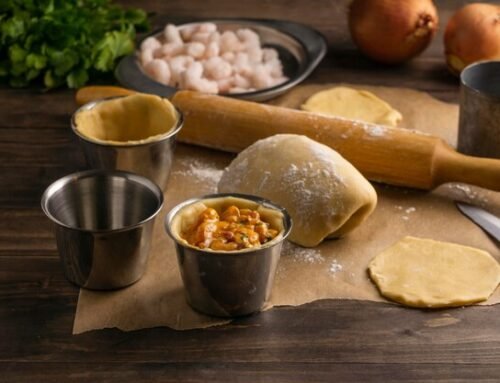Cooking the perfect beef brisket is an art form that requires patience, dedication, and the right techniques. This flavorful and tender cut of meat is a barbecue favorite and a staple in many traditional dishes. Whether you’re preparing it for a family gathering, a festive occasion, or simply to enjoy a hearty meal, knowing how to cook brisket properly will ensure that it’s juicy, tender, and full of smoky flavor.
In this guide, we’ll cover everything you need to know about cooking the perfect beef brisket, including preparation tips, cooking methods, seasoning suggestions, and common mistakes to avoid.
1. Understanding Beef Brisket
Beef brisket is a cut of meat from the lower chest of the cow. It’s a tough, muscular piece of meat with a rich layer of fat that melts during the cooking process, giving it a delicious flavor.
Types of Brisket Cuts
- Flat Cut: Leaner and ideal for slicing, often preferred for formal presentations.
- Point Cut: Has more fat and is more flavorful, perfect for shredding or making burnt ends.
Choosing the right cut depends on your preferred cooking method and the occasion.
2 Essential Tools and Ingredients
Tools You’ll Need:
- Smoker or Grill (for traditional BBQ brisket)
- Oven or Slow Cooker (for indoor cooking)
- Meat Thermometer
- Aluminum Foil or Butcher Paper
- Sharp Knife for trimming
- Cutting Board
Ingredients:
- Beef Brisket (10-12 lbs recommended)
- Olive Oil or Mustard (for binding the rub)
- Salt and Black Pepper
- Garlic Powder
- Onion Powder
- Paprika
- Brown Sugar
- Cayenne Pepper (optional for heat)
- Apple Cider Vinegar or Beef Broth (for spritzing)
3. Prepping the Brisket
Proper preparation is key to a tender and flavorful brisket.
Step 1: Trim the Fat
- Remove excess fat from the brisket, leaving about ¼ inch for flavor and moisture.
- Trim off any silver skin and thick hard fat that won’t render during cooking.
Step 2: Apply the Rub
- Coat the brisket with olive oil or mustard as a binder.
- Generously apply your seasoning rub, making sure to cover all sides.
- Let it rest at room temperature for 30-60 minutes to absorb the flavors.
4. Choosing the Best Cooking Method
There are various ways to cook a beef brisket, but the most popular methods are smoking, baking, and slow cooking.
Method 1: Smoking the Brisket
- Temperature: 225-250°F (107-121°C)
- Time: 1.5 hours per pound
- Use wood like oak, hickory, or mesquite for a rich smoky flavor.
- Wrap the brisket in butcher paper or foil once it reaches an internal temperature of 165°F (74°C) to retain moisture.
- Cook until it reaches 203°F (95°C) for optimal tenderness.
Method 2: Oven-Baked Brisket
- Temperature: 300°F (150°C)
- Time: 5-6 hours for a 10 lb brisket
- Place the brisket in a roasting pan with beef broth or apple cider vinegar.
- Cover with foil and cook until tender, checking every hour.
Method 3: Slow Cooker Brisket
- Time: 8-10 hours on low or 5-6 hours on high
- Add broth, onions, and garlic to the slow cooker for added flavor.
- Ensure the brisket is fully submerged for even cooking.
5. Tips for a Perfect Brisket
- Low and Slow is Key: Brisket requires patience. Cooking at a low temperature for a long time ensures it becomes tender.
- Let it Rest: After cooking, allow the brisket to rest for at least an hour. This redistributes the juices for a more succulent bite.
- Slice Against the Grain: Cutting against the grain makes the meat more tender and easier to chew.
- Use a Meat Thermometer: Avoid guesswork by checking the internal temperature frequently.
- Spritz for Moisture: During smoking, spray the brisket every hour with a mixture of apple cider vinegar and water to prevent it from drying out.
6. Common Mistakes to Avoid
- Not Trimming Properly: Leaving too much fat can lead to greasy brisket, while removing too much fat will make it dry.
- Cooking at High Temperatures: Rushing the process can result in tough meat.
- Skipping the Resting Period: Without rest, the juices will escape, leading to dry brisket.
- Not Monitoring Temperature: Always rely on a meat thermometer rather than visual cues.
7. Serving Suggestions
A perfectly cooked brisket pairs well with various sides and sauces. Here are a few ideas:
- Classic BBQ Sauce
- Coleslaw
- Baked Beans
- Cornbread
- Potato Salad
- Grilled Vegetables
You can also use leftover brisket for sandwiches, tacos, or brisket chili.
Also Read : The Ultimate Cajun Crawfish Boil Recipe For Seafood Lovers
Conclusion
Cooking the perfect beef brisket is a rewarding experience that brings rich flavors and a melt-in-your-mouth texture. By following these tips and tricks, you’ll be well on your way to mastering the art of brisket preparation. Remember, patience is key — low and slow cooking yields the best results.
Whether you’re enjoying a backyard barbecue or a family dinner, a well-cooked brisket is sure to be the star of the table. Happy cooking!
Frequently Asked Questions (FAQs)
1. What is the best cut of brisket for smoking?
The point cut is ideal for smoking because of its higher fat content, which enhances the flavor and tenderness.
2. How long should I smoke a brisket?
It typically takes about 1.5 hours per pound at 225-250°F. A 10 lb brisket may take 15-18 hours.
3. Can I cook a brisket in advance?
Yes! Brisket often tastes even better the next day. Store it in an airtight container in the refrigerator and reheat slowly.
4. How do I keep my brisket moist during cooking?
Use a water pan in the smoker, spritz with apple cider vinegar, and wrap the brisket when it reaches 165°F.
5. Should I marinate brisket before cooking?
Marinating is optional but can enhance flavor. A dry rub is typically enough for a well-seasoned brisket.
6. What wood is best for smoking brisket?
Oak, hickory, and mesquite are popular choices for their strong, smoky flavors. For a milder taste, try fruit woods like apple or cherry.
7. Can I cook brisket without a smoker?
Absolutely! You can bake it in the oven or use a slow cooker for a tender, juicy result.
8. How do I know when my brisket is done?
Brisket is done when it reaches an internal temperature of 203°F and feels tender when probed.
9. How long should I let my brisket rest?
Allow your brisket to rest for at least one hour, wrapped in foil, to lock in the juices.
10. Can I freeze cooked brisket?
Yes, cooked brisket can be frozen for up to 3 months. Slice it before freezing for easier reheating.











Leave A Comment